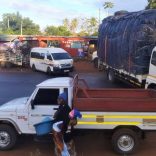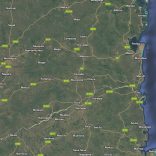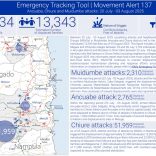Outrage as thefts of hoes and capulanas rise at funerals in Nampula's Mukhura cemetery
‘Calamities’: Second hand clothing and articles highly sought after in Mozambique

Imported used clothing, commonly known as 'calamidade' ['calamity'], comes mainly from China, Germany and England. In Nampula, it is a growing business and authorities are turning a blind eye to illegalities.
Calamity: Preferred for price and variety
Calamity is the name given to the second-hand goods much sought after by thousands of Mozambican citizens not only for quality but also for price. An article of clothing can cost as little as 10 meticais [about EUR 0.15], but the quality varies. This creates a flood of people when the new bundles are opened.

Stores specialised in supplying ‘calamity’
Many stockists in Nampula import used clothing. One of the examples is ADPP Vestuário Nampula, which, in the capital city in the north, has three wholesale stores selling garments to retailers.

Calamity bundles
The price of bundles varies due according weight, quality and quantity. At warehouses, bales range from five to seven thousand meticais [EUR 70 – EUR 100], while others can cost 40,000 meticais [about EUR 570]. Bundles may contain clothing, blankets and footwear, all used.

‘Calamity’ is not just clothing
But ‘Calamity’ is not just about second-hand clothing. There are also ‘calamity’ objects such as toys, motorcycles and bicycles. There is a lot to please children in calamity bundles, and at a price that suits customers’ pockets.

Footwear ‘calamity’
There is second-hand footwear for sale, too, priced according to quality and size. Calamity footwear is highly sought after because, despite being used, those who buy it say it still offers good quality and durability.

School bags with a second life
A simple new school bag or backpack in stores can cost between 400 and 1,800 meticais [EUR 6- EUR 25] in stores. But with ‘calamity’, it’s all different. For only 200 meticais [about EUR 3] it is possible to find articles of incontestable quality, those who opt for this type of article say.

Good blankets
Some say calamity blankets and pillowcases are better than new ones. Prices are also low – you can buy a blanket for as little as 250 meticais [about EUR 3.50].

Calamity markets proliferate
In Nampula, there are no rules governing the second-hand trade. New informal markets emerge every day, many are born in the streets and on the pavements of the city. Even at the minibus and bus stops there are busy informal markets.

Sellers “rob” the streets
In almost all of the city’s 18 neighbourhoods, there are markets selling second-hand clothing – but some vendors actively pursue customers. “Sitting down doesn’t make money, but chasing after the customer does,” one hawker who walks the streets with his stock points out.

A new “market” to be born in the Hospital
Pedestrian traffic has seen a new second-hand market emerge before the very eyes of the municipal and hospital authorities in the backyard of the Nampula Central Hospital, the largest health unit in the north of the country. There on the wall can be found can be found a comprehensive display of blankets, towels and pillowcases.

Select to attract customers on the streets
Maurício Ossumane has been a street vendor for more than 10 years. He bets on a personalised offering, buying only article he thinks will suit his customers. ”I make enough money to live, but only just. I worry mainly about ‘marginals’, who sometimes steal our products, like cell phones, but I’ll stick with the business until I get a permanent job,” he explains.

Places of sale with poor hygiene conditions
Not all markets have ideal conditions for trading. Cavalaria, in the Carrupeia neighbourhood, is one of Nampula’s largest, but conditions are poor in places. The water pipes frequently burst, leaving a muddy and difficult environment. But sellers do not even consider leaving the place because of the sustenance it provides.












Leave a Reply
Be the First to Comment!
You must be logged in to post a comment.
You must be logged in to post a comment.